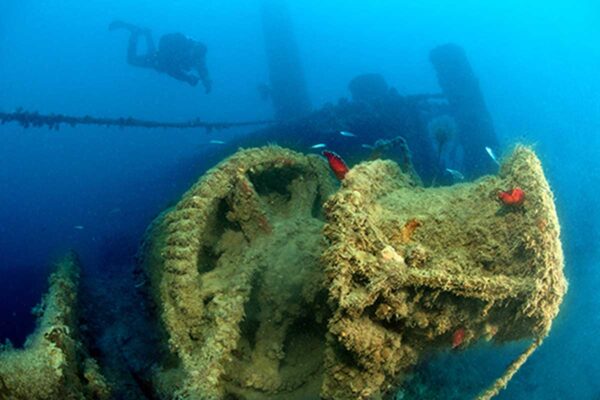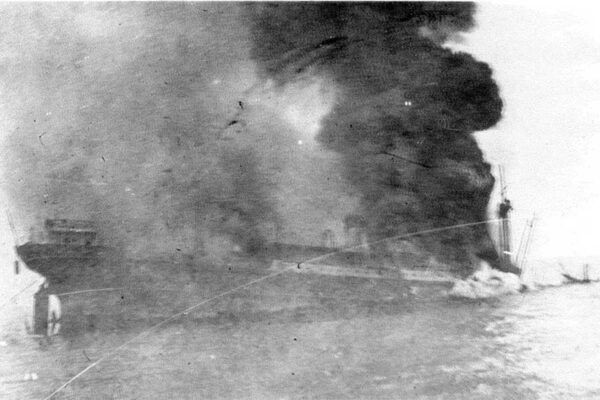
Motor ship, An Italian wreck of the Second World War, Shipwreck of 1940, Depth 31 meters (101 feet)
On board the steamer there were over nine hundred soldiers: most of them came from Tuscany, and in particular from three Florentine departments.
A forgotten tragedy, as someone called it, or in any case little known. It is that of the sinking of the Paganini motor ship, which exploded on 28 June 1940 off the coast of Durres. On board the steamer there were over nine hundred soldiers: most of them came from Tuscany, and in particular from three Florentine departments.
The sinking of the “Paganini” motor ship was perhaps the first disaster of the Second World War. In those days, troops were piling up in Albania for the occupation of Greece. On the evening of June 27, 1940, the Paganini motor ship sets sail from Bari en route to Durres. It is a civilian ship of just under 2,500 tons, chartered to Tirrenia.
At sunset on June 27, the convoy, made up of the Paganini, a tanker ship and the destroyer escort ship Fabrizi, left for Albania.
On June 28 the ship M / N PAGANINI has a start caused by an explosion in the hold N.2. Immediately a furious fire flares up, the cause of which is still controversial.The flames immediately rise very high, screams, desperation, panic. The shipwreck takes place at 6.15 am while the motor ship is located off Durres.
On board the steamer, which can carry 58 passengers, in addition to goods, there are over 900 soldiers of the nineteenth artillery regiment and a section of the Military Geographical Institute, both stationed in Florence.
Most come from the Province of Florence, others from the surrounding cities and areas: Mugello, Chianti, Val di Sieve, Valdarno. Of these areas there are numerous fallen, missing and shipwrecked who were rescued. Hundreds of soldiers from the Val di Sieve were present in Albania, classified in the Regiments of the Venice Division.
Of the approximately 220 dead and missing, according to the list published since the evening of 11 July, 90% of the victims were in force at the 19th Artillery Regiment of the Venice Infantry Division stationed in Florence, based in the Baldissera Barracks, known as the Mint.
In a sea of fire, relief efforts are difficult and scarce, despite the proximity of the Albanian coast. For many days there is no news, then on 11 July the family learned from the newspapers about the fate of their loved ones.
The ministry of war sends the usual cold words of circumstance to the families. The war bulletins will never speak of what happened.
According to investigations carried out by the Tirana court in July 1940, the fire, which broke out in the hold n. 2 of the ship, is due to sabotage.
 How many were the dead, the missing, the maimed? Uncertainties and bureaucratic deficiencies have fueled for years the hopes of those who do not resign themselves to the end of their loved ones. Then there is the mystery of the great disabled: tortured wounded, deprived of the limbs and sight that would have been hosted in some Florentine institutes. This is also a circumstance that would have fueled the hope of some mothers and wives who have been looking for their loved ones for years.
How many were the dead, the missing, the maimed? Uncertainties and bureaucratic deficiencies have fueled for years the hopes of those who do not resign themselves to the end of their loved ones. Then there is the mystery of the great disabled: tortured wounded, deprived of the limbs and sight that would have been hosted in some Florentine institutes. This is also a circumstance that would have fueled the hope of some mothers and wives who have been looking for their loved ones for years.
Paganini’s shipwreck went by in silence, for almost seventy years almost nothing was known. What really happened? How many are the dead and missing? There are many mysteries that have wrapped the end of the ship which cost the lives of over 219 soldiers, according to official sources, according to others the total figure would be 340 men. The background to the tragedy is the pressure and the unpreparedness that characterizes Italy’s entry into the war and the Paganini affair is clear proof of this: soldiers, weapons, mules, straw, hay and machinery are arranged in bulk in the holds and piled up on deck, there are no lifeboats and escape routes are not adequate for the fast abandonment of the ship, life jackets are not adequate and many do not know how to use them.
The official historiography has forgotten about Paganini, which has remained in the memory of many. Every year in the basilica of the Santissima Annunziata in Florence a Mass is celebrated in suffrage of the fallen. The appointment will also be repeated this year at 12 on Monday 28 June.
THE DIFFICULT RECOVERY OF THE WATERWAYS
Fabrizi joined Paganini on the side where more men had concentrated, and the crew of the torpedo boat went out of their way to recover as many men as possible. In all the torpedo boat managed to rescue 437 shipwrecked, including several injured and burned, even seriously.
The Paganini wreck, whose position was known to some inhabitants of Durres, was found and identified in January 2009 by a group of divers led by Cesare Balzi. The ship lies 35 meters deep at 2.4 miles from the shore between Durres and Capo Pali (and four miles from the exit of the port of Durres), skidded 45 degrees to the left, with the upper structures reaching 28 meters ; the bow faces southwest, with a 210 ° course. The forward area is the most damaged, with part of the bridge and the bridge that collapsed (not only due to the effect of the fire, but also due to the dynamite fishing carried out by some local fishermen), while the stern is relatively well preserved , in particular the extreme stern, the only part of the ship not to have been reached by the fire of 28 June 1940. The internal rooms are covered with a layer of sand and mud. The Paganini bell has been recovered and restored and is preserved by the National Center of the Stocktaging of Cultural Properties of the Ministry of Tourism, Culture, Youth and Sports of Albania, in Tirana.
Every year, on June 28 – since 1941, the fallen of Paganini are commemorated with a mass celebrated in the Basilica of the Santissima Annunziata in Florence.
SOME TECHNICAL AND HISTORICAL DATA
- Mixed motor ship of 2424 (or 2427) tsl, 1421 tsn and 2985 tpl
- 85.34-89.61 m long, 12.19 wide and 6.4 fishing
- with a maximum speed of 13.7 knots.
- Belonging to the Tirrenia Anonymous Navigation Company, based in Naples, and registered with serial number 55 in the Maritime District of Rijeka.
